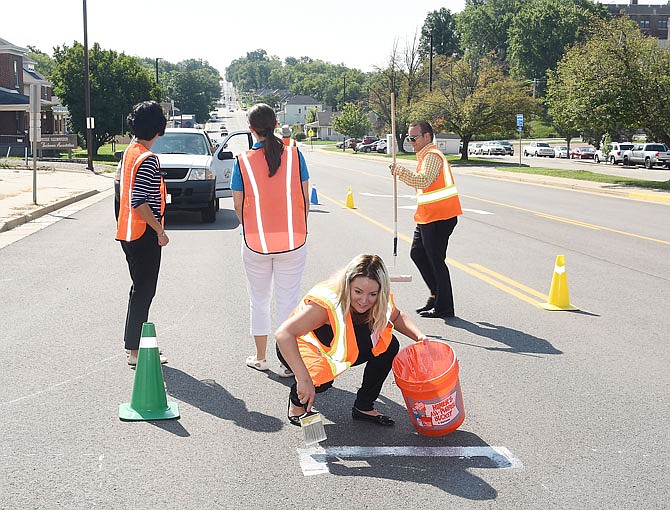Folks from all over the state spent several hours Friday morning painting temporary stripes on McCarty Street and placing flowers and orange cones in traffic lanes.
As part of the 2018 Missouri Active Transportation Summit, the amateur street engineers were creating temporary "bump outs" so they could see how they would affect traffic on the busy corridor. Bump outs, also known as curb extensions, narrow the roadway, creating shorter crossings for pedestrians and cyclists. They cause drivers to slow and can be used as spaces for furniture, lighting and plants.
The summit is a chance for people to gather and share ideas for making communities more active, vibrant and healthy. They also can discuss ideas that might make communities more economically sustainable through bicycling, walking and incorporation of trails, according to the Association of Pedestrian and Bicycle Professionals.
Organizers hosted 12 breakout sessions in the Jefferson City Police Department, City Hall and on the streets throughout the day. Breakouts included lessons learned as Boonville expanded trails, the economic and health benefits to cycling in Northwest Arkansas, how to create "pop-up traffic calming demonstrations," creating the Missouri Trails Project, discussions about Springfield's pedestrian-friendly community plan, a look at Kansas City trail efforts, attempts to establish a U.S. bike route, discussions on the Rock Island Trail and more.
How people use the state's transportation system is transforming.
Missouri's $2.6 billion transportation budget was the subject of a keynote speech delivered by Eric Schroeter, state design engineer. Schroeter pointed out to listeners gathered in the Jefferson City Police Department classroom that the department maintains the country's seventh-largest road system with a budget that ranks 46th in dollars per mile.
He said the state works on hundreds of bridges a year. At the same time, another 100 bridges per year are assessed as being in poor condition. It costs $100 million to build a bridge across the Mississippi River, he added.
"We need to be doing several of those a year, and we're not keeping up," Schroeter said.
Schroeter said the state's transportation in the future is uncertain. There are about 750,000 people ages 16-24 in Missouri. That's prime working age, he said. But only 72 percent of them have driver licenses.
"What's their mobility, and how do they get around?" he asked several hundred people gathered for the event. "Unfortunately, one of the things we know is that in Missouri, if you don't drive, you don't work."
That's especially true in rural communities, Schroeter said.
The American love affair with the automobile is changing, he said, which affects transportation in the future.
"This is the generation behind us coming forward," he said. "They view transportation differently than us."
Data, he said, show 81.5 percent of workers drive to their jobs alone; 9.3 percent carpool; and other small groups take public transportation, walk or use other means of transportation.
But 4.4 percent of Missourians work from home.
Several of his listeners had attended the McCarty Street breakout session, led by Taylor March. March, an advocacy and education manager for Trailnet, an organization dedicated to improving walking and biking opportunities for Missourians, said the organization is focused on safety.
"We're trying to make it safer and easier to walk, bike and take transit," March said.
One way is to research whether bump outs, roundabouts or other traffic controls will help. Trailnet maintains "libraries" in St. Louis, Kansas City and Springfield of products to use for temporary traffic controls - cones flowers, tires, (temporary) chalk paint, orange vests and even radar guns to see if traffic is slowed by the changes.
"It is a tool to model transportation changes in practical ways," March said. "This is an opportunity for city governments or neighborhoods to advocate before there's a (permanent) physical change."
As summit attendees set up the bump outs, March explained Trailnet had done similar demonstrations on five-lane-wide streets with 30-mph speed limits. He described the bump outs on McCarty Street as "medium-sized."
They were a little more than 9 feet deep.
Bump outs are important for bicycles and pedestrians, said Ashley Varner, healthy community coordinator at Capital Region Medical Center. They may be another step toward making Jefferson City a more pedestrian and bike-friendly city.
"This is one component of 'complete and livable' streets," Varner said.
She explained that in the past, some design choices for streets were intended only for automobiles.
The thinking now is that complete streets must include three things: sidewalks, bike lanes and Americans with Disabilities Act accessibility (including appropriate crosswalks).

